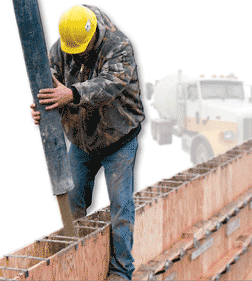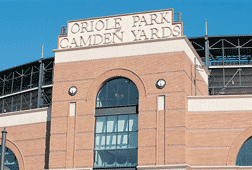|
|||||||||||||||||
A Tale of Two BusinessesMaking Global Warming Solutions the law would forever change ‘business as usual’by Carrie Madren
We’re warned to expect climate change in this century if we don’t cut our air pollution emissions. Scientists say the effects could get very personal, from spreading disease to wet feet from more frequent storms and rising sea levels. As you read this story, Maryland lawmakers are taking that warning to heart. They’re considering a Global Warming Solutions Act that would give us, the eighth smallest state in the nation, the most stringent laws in the country. The year 2006 would be the benchmark. Come 2020, we’d have to get 25 percent cleaner. By 2050, we’d have to manage an amazing 90 percent cut from pollutant levels at century’s turn. It’s like stopping a runaway train. Making Global Warming Solutions the law would forever change business as usual. For under the legislation, putting the brakes on emissions would begin with industry. Some companies predict that they will have to shut down if the bill is enacted. Others are lobbying legislators to pass the bill. Bay Weekly followed up with two companies, one against the bill and one behind it. Cutting Emissions, Good for BusinessCeraTech envisions prospering in a cleaner economy. “The construction industry, and in particular the manufacture of cement for concrete, generates nearly 10 percent of the world’s greenhouse gases,” Mike Riley, CTO of the Baltimore-based cement and concrete designer, manufacturer and supplier, said last week at a rally organized by Alliance for Global Warming Solutions. Much of the concrete we see every day — in everything from sidewalks to storm drains — is made from Portland cement, explained another company spokesman, Leo Kahl. To make Portland cement takes raw, mined materials, clay and lime that are heated in an energy-sapping, 2,000-degree kiln that releases a ton of carbon dioxide for every ton of cement produced. Riley and Kahl’s company developed and sells a greener cement that replaces raw materials with 95 percent fly ash, a byproduct of coal-fired power plants. For their cement, powders are mixed, not baked, with no carbon dioxide emission, Kahl said. Putting the breaks on production pollution opens new markets for green construction products and makes the state an ally, Riley explained. “We strongly believe states … should mandate the use of green construction products in all new construction,” he testified. That’s easy for Riley to say. Like many of the other 499 businesses that rallied with the Alliance for Global Warming Solutions, he won’t pay the price. Green manufacturers and promoters of sustainable solutions are ahead of the curve. The cost falls on businesses invested in traditional technologies. Cutting Emissions, Cutting BusinessOne of those is Redland Brick Inc. Redland Brick owns two Maryland kilns — one in Williamsport in Washington County and one near Thurmont in Frederick County. The kilns produce more than 100 million bricks every year. Those bricks built the Miller Senate Office Building, the Lowe House Office Building, Oriole Park at Camden Yards, the Ravens M&T Stadium, plus some of the University of Maryland and Johns Hopkins University. “We’re invested in energy-efficient technology,” Joe Miles, Redland Brick’s president and CEO, told the Senate Committee on Health, Education and the Environment. To make bricks, he explains, he uses natural gas, which produces less greenhouse gases than other fuels. The Williamsport plant controls other pollutants, hydrogen fluoride and hydrochloric acid, with a scrubber, according to Barry Miller, Redland Brick’s environmental manager. But Miles told the committee in mid-February, “there is no technology to reduce carbon dioxide for brick kilns.” A Cap-and-Trade FutureSo companies like Redland, which have no technological escape hatch, would have to pay to do business. They could buy pollution permits from the state for the carbon dioxide they can’t cap, or trade credits with other companies. Two other greenhouse gases, nitrogen oxide and sulfur dioxide, are already capped and traded, as carbon dioxide would be under Global Warming Solutions. “We have a cap-and-trade program for power plants now,” says Brad Heavner, director of Environment Maryland, one of the leading groups in the Alliance.
That system began when the General Assembly voted Maryland into the Regional Greenhouse Gas Initiative last year. Global Warming Solutions would take that existing cap-and-trade program and expand it to other sectors, he says. It’s that broader cap-and-trade system that worries Miles. To cut greenhouse gases any further, he said, “we would have to cut production.” Slashing production would mean not only a cut in profits but also fewer local bricks on the Maryland market. That would be a shame, because bricks are among the greenest building products available, the manufacturer claims. “Bricks last hundreds of years,” Miller says. “You can tear a building down and reuse or recycle bricks, as opposed to taking them to the landfill like some other building materials.” If his company has to cap carbon, Miles says, it would soften a competitive disadvantage. Cutting back production would mean that more bricks would have to be trucked in from out of state — meaning more greenhouse gases produced by transportation. Devil in the DetailsLobbyists urging Maryland to pass Global Warming Solutions say that won’t happen. “It’s not in the interest of state government to shut down a business,” says Heavner. “If a company can’t meet or afford their limits [without lowering their production], they could get an exemption.” How that might work is part of a foggy future. The bill doesn’t specify exactly how pollution credits would be allotted or how much they would cost. The details of regulation would be written by the Maryland Department of Environment over the next four years, if the legislation passes. Knowing that an exemption could be possible doesn’t make Miles feel any warmer toward the bill. If there’s really going to be an exemption, Miles says, “put it in the bill.” He says lawmakers and the Department of Environment have assured him, saying “you guys are already efficient, so you’ll be okay.” But the devil’s in the details, continues Miles, who hopes to grow his business with another brick plant soon. He sees an uncertain future ahead, as the General Assembly considers passing rules and regulations not yet fully written. Slowing the effects of global warming keeps everyone’s feet drier, but who pays the price to bring about change? That’s what our lawmakers are pondering now. Legislation has been heard in both the House and Senate committees; the House Environmental Matters committee is expected to vote within a week. |
|||||||||||||||||
|
|||||||||||||||||
|
|
|||||||||||||||||
|
© COPYRIGHT 2008 by New Bay Enterprises, Inc. All rights reserved. |
|||||||||||||||||



